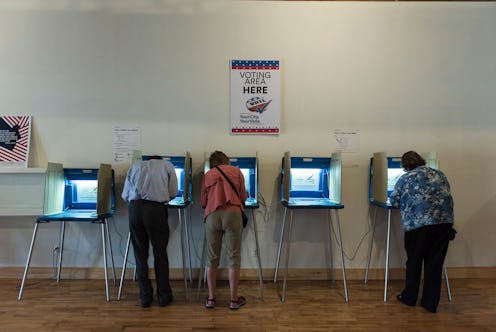News
Your Vote Matters To The Electoral Vote Total
On Nov. 8 (not Nov. 28, regardless of what Donald Trump says), Americans will go to polling places across the country to cast their votes for president, but they won't directly elect any candidate. Rather, they'll tell their states' representatives in the electoral college how to vote on their behalf. It's a process that can be difficult to understand, but the difference between the electoral vote and the popular vote actually shows why your vote matters in the presidential election.
The popular vote is pretty simple. Eligible, registered voters go to polling places or send in absentee ballots to cast their votes for president. The candidate who receives the most votes wins the popular vote. In 2012, for instance, President Obama won the popular vote with more than 65 million votes, according to the national archives. Republican candidate Mitt Romney garnered just over 60 million votes.
The electoral vote isn't as straightforward. It's decided by the electoral college, that seemingly amorphous entity that only becomes relevant every four years. In reality, the electoral college is composed of 538 electors, one for each member of Congress, plus three for the District of Columbia. In all cases other than D.C., a state's amount of representation in Congress decides how many electoral votes it has in presidential elections.
A state's electors typically vote based on the state's popular vote. In 48 states, electoral votes follow a winner-take-all model, with the candidate who receives the majority of the state's popular vote earning all of the state's electoral votes. In Nebraska and Maine, however, electoral votes are allocated based on a candidate's proportion of the state's popular vote. In other words, if a candidate earns three-fifths of the popular vote in Nebraska, then three of Nebraska's five electoral votes go to that candidate. When it's all said and done, a candidate must win a majority — at least 270 — of electoral votes to win the White House. Otherwise, the ultimate decision goes to Congress.
The obvious difference between the popular vote and electoral vote is the use of electors, or representatives for each state, in the electoral college. The electoral college is similar to the delegate system used in primary voting. The more meaningful difference between the electoral vote and the popular vote, though, is what it means for voters on a state-by-state level.
Let's say you vote in the commonwealth of Virginia. Your vote for president isn't just one vote out of the roughly 120 million votes that may be cast on Nov. 8, based on previous election results. Rather, it's one vote out of the roughly 4 million votes in Virginia that could be cast on election day. (In 2012, some 1.9 million people voted for Obama, whereas some 1.8 million voted for Romney, according to the national archives.) Don't get me wrong — one out of 4 million still may not seem very impactful, but each vote in Virginia helps to decide how the state's 13 electoral votes are allocated.
Usually — but not always — the electoral vote follows the result of the popular vote, and the person who wins the popular vote also wins the electoral vote. That's what happened in 2012, 2008, 2004, and in almost all other presidential elections in the history of the electoral college. But it is possible for the votes to come out different: in 2000, for instance, George W. Bush won the presidency, despite losing the popular vote to that year's Democratic nominee Al Gore. Bush ended up with 271 electoral votes, while Gore scored 267. The 2000 example serves as a reminder that every state matters in the election results, as the electoral vote was decided by just four votes.
Although the popular vote typically lines up with it, it's the electoral vote that dictates presidential elections in the U.S. As such, it's important for voters in each state to have their say, so that electoral votes can be cast as the majority of voters in a state choose. In other words, after you vote on Nov. 8, pay attention to the electoral college math.
